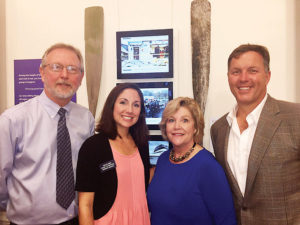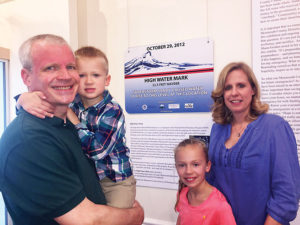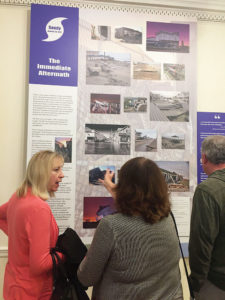By Rick Geffken |
The Monmouth County Historical Association (MCHA) welcomed a steady stream of visitors to its headquarters during an appropriately reminiscent rainy and windy day on Sunday afternoon, Oct. 29 for the opening of its latest exhibit, “Tracking Sandy.”
Charles “Chuck” Jones, MCHA’s interim director, posed this hypothetical to the crowd in his opening remarks: wouldn’t the general public wonder why the 120 year-old historical organization would mount a disaster display? Answering his own question, he quoted Congressman John Lewis’s memorable: “If not us, who? If not now, when?”
As MCHA President Linda Bricker acknowledged: “This exhibit is something very different for our association. We usually have archives and a collection of things we can study.” Bricker said that the idea for “Tracking Sandy” was conceived over a year ago when the MCHA put out a call for anyone who had pictures, videos, art work, or artifacts.
Jones reinforced Bricker’s points: “We started with ‘Where do we gather the information for this?’ Thankfully, we had the academic rigor of Melissa Ziobro to help us do something out of our comfort zone. We felt it was very necessary (to present) the greatest natural disaster in the history of the state, one which affected Monmouth and Ocean counties the most.”
Melissa Ziobro, Monmouth University professor, who was chosen to curate the exhibit, began the process by interviewing survivors of the storm. “MCHA didn’t want to tell the people of Monmouth County ‘This is what happened to you during Super Storm Sandy,’” she said. “We wanted to provide a platform for the people who wanted to tell their story.”

The display team reached out via social media, ListServ messaging distribution, newspapers, and historical societies’ newsletters. The MCHA hosted open houses, and networked to try to spread the word about the project. They gave interviews to news outlets, reaching out to as many people as possible.
Ziobro told the crowd that there were many contributors to the success of Tracking Sandy. She encouraged applause for Cain, two independent reviewers, the MCHA staff, and her three Monmouth University interns.
Stan Cain, a career art director from North Long Branch who has worked on many MCHA projects, designed the “Tracking Sandy” show. He took all the information and pictures the team gathered and worked for months with Ziobro to create the floor-to-ceiling illustrations of Super Storm Sandy’s effect on our coast.
The primary challenge for the curator and the designer was that the items were crowd-sourced, arriving in dribs and drabs over the last year. Cain mentioned the primary difficulty with the Sandy displays: “Nothing was beautiful; we had a negative subject matter. We also didn’t want to favor professional photographers, since this was everyone’s experience, so we tried to be inclusive in what we chose, including low resolution images.”
Certain dominant themes and story lines came out of survivor interviews. These were ultimately divided into nine zones for the display – The Immediate Aftermath; Community Efforts; Rebuilding; etc. – at the 70 Court Street headquarters of the MCHA. Cain used his favorite large-format displays to reinforce the enormity of Sandy.
Monmouth County Freeholder Director Lillian Burry expressed what many felt as they gazed at those pictures and displays: “This may surprise you, but the exhibit is really moving me to feel a lot of emotion,” she said. “Thinking back on that day I truly want to cry at how wonderful the people were and the reaction of our volunteers at what was really like a bad dream.”

Fred Pachman, medical librarian at Monmouth Medical Center, was likewise impressed. “The MCHA really has a great group of people who put up exhibits that tout the history of our county and how it’s integral to the whole of New Jersey. This Super Storm Sandy display is a perfect example. I’m hoping this becomes a travelling exhibit to other parts of Monmouth County.”
“Tracking Sandy” features unique interactive displays. Visitors can describe their impression of the storm by affixing one word Post-It notes on a large poster board. The “What’s in a Name?” illustration shows the varying nomenclatures scientists, insurance companies, and government agencies used for Sandy as it barreled its way toward the New Jersey Shore: sub-tropical depression, tropical storm, hurricane, etc. “This part of our exhibit teaches people to respond to an emergency and not to pick apart the language used to describe it,” Cain said. “It’s an ‘emergency’- listen to what people are recommending.”

Freehold John Curley was effusive in his comments: “The Monmouth County Historical Association is phenomenal, we have to preserve history, to remember where we’ve been before we judge where we are going next.”
Curley continued: “I’m particularly proud when I look at the local municipalities, what the mayors and council members did; police, fire, and first aid responders really rose up to help in what appeared to be, along our coast, a bombing. They really saved lives in a valiant effort.”
But he also cautioned that “we still have a long way to go for the people who are still out of their homes.”
The MCHA encouraged visitors to take home a copy of “Family Disaster Plan” brochure produced and provided by Sheriff Shaun Golden’s Monmouth County Sheriff’s Office. Filling in the brochure’s easy-to-follow sections will provide a quick source for essential emergency information.
Stan Cain emphasized that the “Tracking Sandy” show is available only at 70 Court St., Freehold; not as an online “walk through the museum” exhibition. Museum hours are Tuesdays through Saturdays, 10 a.m. to 4 p.m. Admission is free to MCHA members, $5 for adults, $2.50 for seniors and students.
For information about everything the Monmouth County Historical Association does, you can visit their newly redesigned, and according to Director Jones, “sassy” website at monmouthhistory.org.
This article was first published in the Nov. 2-9, 2017 print edition of The Two River Times.














